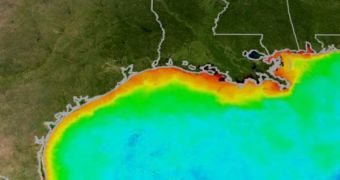Scientists keeping an eye on the dead zone in the Gulf of Mexico, an area where oxygen levels have dropped to such lows that they no longer sustain animal and plant life, have reported that, this year, the formation is smaller than anticipated, but that the overall extent of the damage has increased considerably. The 3,000-mile-wide area has been affected at depths close to the ocean floor until now, but it would appear that the chemical pollutants that are spilled in the Gulf each year have currently added up, and have resulted in the dead zone spreading until it has nearly reached the surface.
The survey was conducted by a team of scientists at the US National Oceanic and Atmospheric Administration (NOAA), led by Nancy Rabalais, PhD, a scientist at the Louisiana Universities Marine Consortium (LUMCON). Earlier this year, in other NOAA-supported studies, experts R. Eugene Turner, PhD, from the Louisiana State University, and Donald Scavia, PhD, from the University of Michigan, predicted that the zone would increase to cover an area of 7,450 to 8,456 square miles.
It would appear that the smaller surface is due to the fact that peculiar weather patterns help re-oxygenate the water, the new investigation proposes. “The winds and waves were high in the area to the west of the Atchafalaya River delta and likely mixed oxygen into these shallower waters prior to the cruise, thus reducing the area of the zone in that region. The variability we see within each summer highlights the continuing need for multiple surveys to measure the size of the dead zone in a more systematic fashion,” Rabalais says.
“The results of the 2009 cruise at first glance are hopeful, but the smaller than expected area of hypoxia appears to be related to short-term weather patterns before measurements were taken, not a reduction in the underlying cause, excessive nutrient runoff. The smaller area measured by this one cruise, therefore, does not represent a trend and in no way diminishes the need for a harder look at efforts to reduce nutrient runoff,” the Director of the NOAA Center for Sponsored Coastal Ocean Research, Robert Manien, PhD, adds.
The dead zones are caused by nutrient runoffs from the mainland, carried especially by the Mississippi River. Thousands of tons reach the ocean each year, and the large amounts of fertilizers from agriculture feed the growth of algae. The organisms then sink to the bottom, where they consume all of the oxygen in the water, which essentially dooms other species living in that ecosystem to death. The situation has reached a point where the $2.8 billion fisheries on the coast are in danger of being affected.

 14 DAY TRIAL //
14 DAY TRIAL //